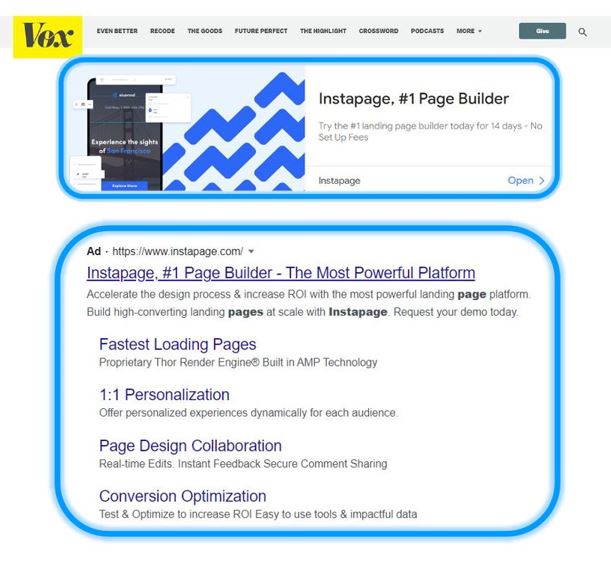Choosing between display advertising and search advertising for online campaigns can be challenging for any business. Making the wrong choice could result in a large portion of your advertising budget being wasted, so it’s crucial that you choose wisely.
But, what’s the difference and how do you know which one is better? It is vital to know when and how to employ display and search in your marketing initiatives because they are crucial components of advertising campaigns.
This blog will cover all you need to know about display and search, including:
- What is display advertising?
- What is search advertising?
- How do display ads work?
- How do search ads work?
- Display ads vs search ads: When to use them
- How display ads and search ads interact
- Tips on how to use display ads and search ads
What is display advertising?
Display advertising is used to put your business in front of customers as they browse the internet. Display ads are visually appealing and occasionally include an image or a video to help you catch users’ attention when they read news articles, make online purchases, or look for businesses comparable to yours.
Websites typically have display ads at the top and sides, but they can also be found within the content itself. By monitoring individuals who match specific online behaviours or demographics, they target the right audience for your business.
What is search advertising?
Search advertising lets you appear on search engine results pages for search queries relating to your business. On popular search engines like Google and Bing, search ads, also known as pay-per-click (PPC) ads, typically appear above organic search results.
Even though they look like organic results, search ads are marked with the word Ad to make it easier for you to distinguish them. To run search ads, you must select a set of keywords, set a budget, and supply additional targeting information, such as your location, to help search engines decide which queries are most appropriate for your PPC advertising to appear.
How do display ads work?
A display ad is a type of advertisement that appears on websites. It used to be the result of direct connections between advertisers and the sites they appear on, and in some circumstances, it still is.
It’s worth mentioning that display networks aren’t exclusive to Google, often national publishers will have their own display networks too, allowing you to advertise to audiences across local and national news websites.
Nowadays, systems like Google Display Network can group websites, categorise them and offer them to advertisers as a package. Advertisers submit bids to these ad networks, and the highest bidders will be awarded space on the websites of their choice. Some advertisers utilise remarketing to connect with internet users who have already visited their websites in addition to just targeting certain websites.
A choice of sizes and images are available when creating an advertisement. This enables more creativity than a text advertisement, making your business stand out.
How do search ads work?
Search ads only appear in search engine results, as opposed to display ads, which can be seen on websites all across the internet. Advertisers choose a list of keywords that are pertinent to their business or products, and they may then place a bid to have their ad appear when a user searches for those particular words or phrases.
Naturally, your business isn’t the only one attempting to connect with individuals using certain keywords. Each search engine advertising platform implements a bidding procedure to choose which ads should be displayed on search results pages. Your chances of appearing for a search keyword increase as your bid rises, and your ad will appear higher when someone searches for that term.
You don’t have to pay every time your advertisement appears on networks like Google Ads. Instead, they employ a pay-per-click model, which as you might expect, means that you only pay when a user actually clicks the advertisement.
Of course, pay-per-click marketing is only one way to increase search engine traffic; another is SEO. In addition to paying for search engine advertising, you can optimise the content of your website to rank higher in organic search engine results. Without incurring additional advertising costs, this can help you increase visitors.
Display ads vs search ads: When to use them
There is one big difference between display ads and search ads: display ads use a push strategy while search ads use a pull strategy. Display ads are displayed to people after they watch videos, read emails, or browse the web, but search ads are typically presented to people who are already looking for your product.
By understanding how these two approaches differ, you can determine the right strategy for your brand or product/service based on its awareness.
When to use display advertising
Below are a few reasons why you might want to run display advertising:
1. To raise awareness
You can use display ads to increase awareness of your business among people who might not even be actively looking for it. As more people become aware of your company, they start to think of you first when they need your products or services.
2. If your product or service is visually appealing
A major advantage of display ads is that they contain images and videos. In addition, this works well for promoting consumer products and services that are heavily reliant upon visual demonstrations.
3. To target specific markets
Because display ads are typically found on websites where potential buyers are already consuming content, they help to successfully drive brand awareness. Google has the ability to match your keywords and advertisements to relevant web pages, which means that by using interested-targeting ads or contextual ads, you can easily cater to a certain audience.
4. To increase your social media following
A well-rounded share of display, search, and social ads is required if you want a healthy, balanced business advertising strategy. Display can increase awareness and draw more followers to your social media sites even if you perform organic social media marketing.
Remember: You can use our free website grader to see how well your online presence is performing, including your display advertising and PPC ads.
When to use search advertising
This next section will examine when you should use search advertising.
1. To increase website traffic
Generating clicks that go to a landing page on your website is the main goal of search ads. Search advertisements are your greatest option if you want to increase traffic to your website from search engines. Ads are an excellent technique for getting people to visit your website and learn more about your business because they are designed to persuade searchers to take action.
2. To attract new leads
When people arrive at your website, additional leads can be generated for your business as a result of search engine traffic. You’re also more likely to turn a searcher into a lead because of the targeted nature of search marketing. As a result, after clicking on a search ad to bring them to your website, they can contact you, submit a form, or buy something with only one click.
3. To improve SEO
Paid search advertisements can ensure impressions on the search results page if your search engine optimisation (SEO) isn’t performing as well as you’d like, or you’re just getting started. While you focus on your local SEO, this will help you ensure that you appear for relevant queries.
How display ads and search ads interact
Display and search advertisements work best when they are used in combination, even if they both have their own uses. As follows:
The effectiveness of search advertising can be improved via display ads
If a person has never heard of your business before, how can they reliably look for it online or click on your advertisement? That awareness is aided by display advertising. Even particular measures, like view-through conversions, are available to monitor the conversions display ads unintentionally generate. This is accomplished by keeping track of those who saw your display advertisement and ultimately converted via a different route.
Target people where they are browsing and spending time with display ads and search ads
While daily searches may only take a few minutes, browsing products/services on the internet can take hours. It’s best to capture them in both scenarios if you want to be completely comprehensive. Use search advertisements to increase your business’s visibility to users who are already actively using search engines to look for services related to your business and use display ads to attract users who have already left the search engine. With this, you’ll be prepared to appear both online and in search results.
Combine display and search retargeting to increase user conversion
Display and search ads combine to create a powerful tool for retargeting website visitors who left without making a purchase. Search advertisements can help you grow your original retargeting audience because they increase traffic. When your search ads have attracted enough traffic for you to retarget, your display ads may take over and start following those audiences throughout the internet.
Your average cost per click can be levelled off with display and search ads
You can counteract a high cost-per-click (CPC) on search with display advertisements if you’ve been having trouble with them. Generally, display ads have a substantially lower CPC than other forms of advertising, including search. As a result, allocate some money to display ads in order to get the most out of your budget. You will lower your overall average CPC by pulling in cheaper display clicks in addition to the maybe more expensive search hits.
Tips on how to use display ads and search ads
Given the benefits of combining display and search advertising, the following advice should get you started:
1. Recognise the metrics for display ads vs search ads
In order to define realistic KPIs for each tactic, it is crucial to understand the metrics to measure for both display ads and search ads. To measure success, PPC metrics like cost-per-click and cost-per-lead are useful. For instance, search ads are designed to generate clicks to your website and leads. However, because display ads are intended to raise awareness, you would probably evaluate cost per impression rather than cost per lead.
2. Maintain brand consistency with display and search ads
Brand consistency is essential for any cross-platform approach. Verify again that your copy in your display and search ads is consistent. Make sure that any promotional dates line up. Additionally, it’s ideal to maintain the same tone and manner.
Tip: To determine if they make sense, try placing them side by side.
 Image Source| Instapage display ad on Vox website and search ads on Google.
Image Source| Instapage display ad on Vox website and search ads on Google.
3. Produce landing pages for display and search campaigns that convert well
Clicks are directed to your landing page by search and display advertising. The responsibility then falls to your landing page to close the transaction and convert that person into a lead. Make sure the action you want potential leads to do is simple for them to access. Testing your landing page for mobile compatibility is another approach to optimise it as display advertisements can appear on different apps.
Want more information on display and search advertising? Check out our blog posts if you want to learn more:
- What Are the Different Types of Display Advertising Formats?
- 5 Examples of Effective Paid Search Advertising Campaigns
You can also contact us to chat with one of our experts about the best option if you’re unsure which one is ideal for your business.








